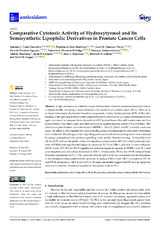Comparative Cytotoxic Activity of Hydroxytyrosol and Its Semisynthetic Lipophilic Derivatives in Prostate Cancer Cells
Autor
León González, A.J.
Sáez Martínez, Prudencio
Jiménez-Vacas, J.M.
Herrero-Aguayo, V.
Montero-Hidalgo, Antonio J.
Gómez Gómez, Enrique
Madrona, Andrés
Castaño, Justo P.
Espartero, José L.
Gahete Ortiz, Manuel D.
Luque, Raúl M.
Editor
MDPIFecha
2021Materia
AnticancerExtra virgin olive oil
Hydroxytyrosol
Prostate cancer
Semisynthetic derivatives
METS:
Mostrar el registro METSPREMIS:
Mostrar el registro PREMISMetadatos
Mostrar el registro completo del ítemResumen
A high adherence to a Mediterranean diet has been related to numerous beneficial effects in human health, including a lower incidence and mortality of prostate cancer (PCa). Olive oil is an important source of phenolic bioactive compounds, mainly hydroxytyrosol (HT), of this diet. Because of the growing interest of this compound and its derivatives as a cancer chemopreventive agent, we aimed to compare the in vitro effect of HT isolated from olive mill wastewaters and five semisynthetic alkyl ether, ester, and nitro-derivatives against prostate cancer (PCa) cell lines. The effect in cell proliferation was determined in RWPE-1, LNCaP, 22Rv1, and PC-3 cells by resazurin assay, the effect in cell migration by wound healing assay, and tumorsphere and colony formation were evaluated. The changes in key signaling pathways involved in carcinogenesis were assessed by using a phosphorylation pathway profiling array and by Western blotting. Antiproliferative effects of HT and two lipophilic derivatives [hydroxytyrosyl acetate (HT-Ac)/ethyl hydroxytyrosyl ether (HT-Et)] were significantly higher in cancerous PC-3 and 22Rv1 cells than in non-malignant RWPE-1 cells. HT/HT-Ac/HT-Et significantly reduced migration capacity in RWPE-1 and PC-3 and prostatosphere size and colony formation in 22Rv1, whereas only HT-Ac and HT-Et reduced these functional parameters in PC-3. The cytotoxic effect in 22Rv1 cells was correlated with modifications in the phosphorylation pattern of key proteins, including ERK1/2 and AKT. Consistently, HT-Ac and HT-Et decreased p-AKT levels in PC-3. In sum, our results suggest that HT and its lipophilic derivatives could be considered as potential therapeutic tools in PCa.

